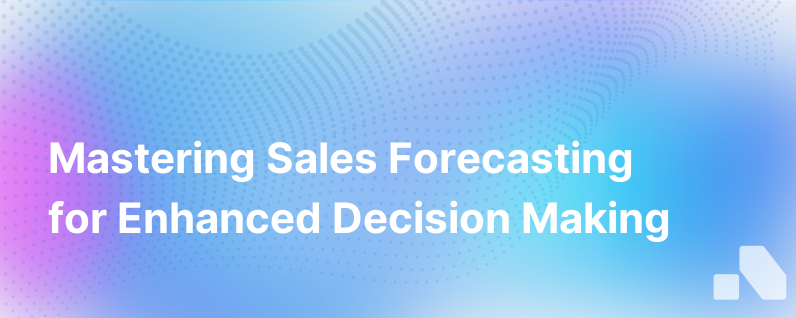
Sales forecasting is a crucial process for any business. It shapes budget planning, informs strategic decisions, and anticipates cash flow. Accurate forecasts enable companies to allocate resources effectively, set realistic goals, and manage performance expectations. Conversely, poor forecasting can lead to misguided strategies, operational inefficiencies, or even financial turmoil.
As businesses evolve amidst volatile markets and increasingly complex sales cycles, the need to refine sales forecasting processes becomes more pronounced. So, how do businesses construct a more robust sales forecasting process that can withstand unpredictability and enhance accuracy? Below are steps and considerations to help create a better sales forecasting process that aligns with organizational needs.
Understanding Sales Forecasting
Sales forecasting is the process of estimating future sales. Accurate sales forecasts provide insight into how a business should manage its workforce, cash flow, and resources while trying to avoid unforeseen cash flow problems.
Though it may sound straightforward, this process can be anything but. Many variables, such as market trends, economic conditions, and even consumer behavior, affect a company's ability to predict future sales. This makes establishing an effective sales forecast challenging but also incredibly valuable.
Key Components of a Strong Forecasting Process
Data-Driven Approach
A robust forecasting process leans heavily on data. Historical sales data, pipeline analytics, industry trends, economic indicators, and customer engagement metrics should all feed into the forecast.
Regular Reassessment
Sales forecasting is not a one-and-done task. As new data becomes available or situations change, forecasts should be evaluated and adjusted. Monthly or quarterly reassessments ensure relevance and accuracy.
Collaboration
Effective forecasts are collaborative efforts. Input from sales, marketing, finance, and product teams provide a holistic view of the business landscape.
Realism over Optimism
While optimism is an excellent quality in sales, it can distort forecasts. It's essential to base predictions on hard data and realistic assumptions, not wishful thinking.
Technological Enablement
Savvy businesses employ technology for more accurate and efficient forecasting. CRM tools, AI algorithms, and advanced analytics can handle complex data scenarios that would confound manual processes.
Steps to Building a Better Sales Forecast Process
1. Defining Objectives
Clarify what you need from your forecast. Is the primary goal to inform financial planning, to set sales targets, or to manage inventory? Objectives will influence methodologies and data points.
2. Classify Sales Stages
Sales don't happen instantaneously; they progress through stages. Understanding and defining these stages within your sales process is crucial for an accurate forecast, as it allows you to assign probabilities to deals based on where they are in the funnel.
3. Selection of Forecasting Models
There’s no one-size-fits-all approach to forecasting. Common models include:
- Lead-driven Forecasting: Based on the number of leads and their conversion rates.
- Opportunity Stage Forecasting: Based on the stages of your sales pipeline.
- Historical Forecasting: Based on historical sales data, assuming patterns will repeat.
- Multivariable Analysis: Combining various factors, including individual rep performance, seasonality, market trends, etc.
The choice should be informed by the complexity of your sales process and the depth of available data.
4. Implementation of Technology Solutions
Leverage technology to handle data complexity and remove biases. A robust CRM can track and analyze data, artificial intelligence can predict trends, and advanced reporting tools can present findings in an accessible format.
5. Integrating Data Sources
Sales forecasting should incorporate data from internal and external sources. This includes CRM data, market trends, competitor analysis, and even regulatory changes.
6. Continuously Updating Assumptions
Market conditions, product offerings, and sales strategies evolve. Periodically review and update the assumptions underpinning your forecasts to keep them accurate.
7. Analyzing Performance
Compare forecasted performance to actual results to understand forecast accuracy. Analyze discrepancies to refine your approach.
8. Training Sales Team
Ensure your sales team is well-versed in the forecasting process. Their ability to update deal stages accurately and input reliable data is foundational to forecasting success.
9. Encouraging Interdepartmental Communication
A forecast can benefit from insights across the organization. Regular communication between sales, marketing, finance, and product departments can surface essential context for the forecast.
10. Documenting and Reviewing the Process
Keep your process documented, encouraging consistency and accountability. Regularly review the process itself to seek improvements in efficiency and accuracy.
Best Practices for Effective Sales Forecasting
Focus on Pipeline Management
A well-managed sales pipeline is critical for accurate forecasting. This means ensuring that sales activities are logged correctly, opportunities are categorized appropriately, and deals are updated in real-time.
Use Predictive Analytics
Predictive analytics can forecast future sales based on patterns found in historical and transactional data. This can significantly improve the accuracy of your forecasts by leveraging vast amounts of data and sophisticated algorithms.
Empower with Training
Training is critical. Make sure that your sales team understands the importance of accurate forecasting and is trained in the tools and methods you use.
Foster a Culture of Accuracy
Incentivize accuracy, not just closed deals. If the sales team is rewarded just for selling, irrespective of the forecast, they have little incentive to input accurate forecast data.
Learn From the Past
Every forecast is a learning opportunity. Use your forecasting history to identify trends and patterns that can refine future forecasts.
Conclusion
Improving your sales forecast process is an ongoing effort. As markets, products, and teams evolve, so too should your forecasting methodologies. By continually revising your processes, adopting the right technologies, and fostering collaboration across your organization, your sales forecasts can become a powerful tool for business planning and strategy.
In today’s data-driven environments, platforms like Aomni can make structuring this forecast process smoother by utilizing AI for real-time analytics and insights, ultimately aiding in more accurate and dependable forecasts.